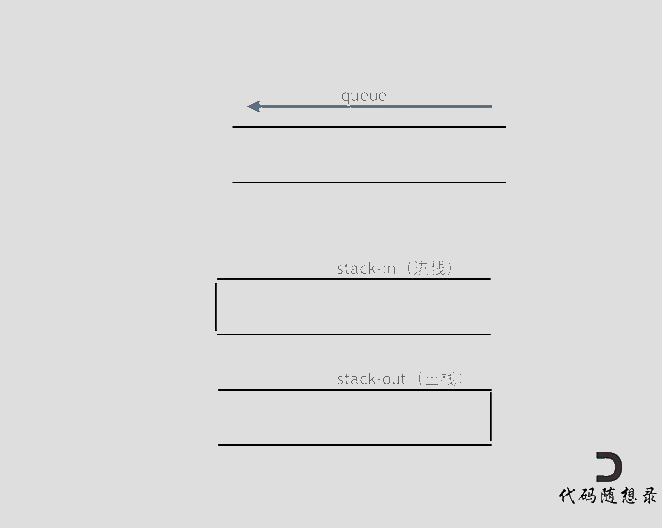欢迎大家参与本项目,贡献其他语言版本的代码,拥抱开源,让更多学习算法的小伙伴们收益!
工作上一定没人这么搞,但是考察对栈、队列理解程度的好题
https://leetcode-cn.com/problems/implement-queue-using-stacks/
使用栈实现队列的下列操作:
push(x) -- 将一个元素放入队列的尾部。 pop() -- 从队列首部移除元素。 peek() -- 返回队列首部的元素。 empty() -- 返回队列是否为空。
示例:
MyQueue queue = new MyQueue();
queue.push(1);
queue.push(2);
queue.peek(); // 返回 1
queue.pop(); // 返回 1
queue.empty(); // 返回 false
说明:
- 你只能使用标准的栈操作 -- 也就是只有 push to top, peek/pop from top, size, 和 is empty 操作是合法的。
- 你所使用的语言也许不支持栈。你可以使用 list 或者 deque(双端队列)来模拟一个栈,只要是标准的栈操作即可。
- 假设所有操作都是有效的 (例如,一个空的队列不会调用 pop 或者 peek 操作)。
这是一道模拟题,不涉及到具体算法,考察的就是对栈和队列的掌握程度。
使用栈来模式队列的行为,如果仅仅用一个栈,是一定不行的,所以需要两个栈一个输入栈,一个输出栈,这里要注意输入栈和输出栈的关系。
下面动画模拟以下队列的执行过程如下:
执行语句: queue.push(1); queue.push(2); queue.pop(); 注意此时的输出栈的操作 queue.push(3); queue.push(4); queue.pop(); queue.pop();注意此时的输出栈的操作 queue.pop(); queue.empty();
在push数据的时候,只要数据放进输入栈就好,但在pop的时候,操作就复杂一些,输出栈如果为空,就把进栈数据全部导入进来(注意是全部导入),再从出栈弹出数据,如果输出栈不为空,则直接从出栈弹出数据就可以了。
最后如何判断队列为空呢?如果进栈和出栈都为空的话,说明模拟的队列为空了。
在代码实现的时候,会发现pop() 和 peek()两个函数功能类似,代码实现上也是类似的,可以思考一下如何把代码抽象一下。
C++代码如下:
class MyQueue {
public:
stack<int> stIn;
stack<int> stOut;
/** Initialize your data structure here. */
MyQueue() {
}
/** Push element x to the back of queue. */
void push(int x) {
stIn.push(x);
}
/** Removes the element from in front of queue and returns that element. */
int pop() {
// 只有当stOut为空的时候,再从stIn里导入数据(导入stIn全部数据)
if (stOut.empty()) {
// 从stIn导入数据直到stIn为空
while(!stIn.empty()) {
stOut.push(stIn.top());
stIn.pop();
}
}
int result = stOut.top();
stOut.pop();
return result;
}
/** Get the front element. */
int peek() {
int res = this->pop(); // 直接使用已有的pop函数
stOut.push(res); // 因为pop函数弹出了元素res,所以再添加回去
return res;
}
/** Returns whether the queue is empty. */
bool empty() {
return stIn.empty() && stOut.empty();
}
};
可以看出peek()的实现,直接复用了pop()。
再多说一些代码开发上的习惯问题,在工业级别代码开发中,最忌讳的就是 实现一个类似的函数,直接把代码粘过来改一改就完事了。
这样的项目代码会越来越乱,一定要懂得复用,功能相近的函数要抽象出来,不要大量的复制粘贴,很容易出问题!(踩过坑的人自然懂)
工作中如果发现某一个功能自己要经常用,同事们可能也会用到,自己就花点时间把这个功能抽象成一个好用的函数或者工具类,不仅自己方便,也方面了同事们。
同事们就会逐渐认可你的工作态度和工作能力,自己的口碑都是这么一点一点积累起来的!在同事圈里口碑起来了之后,你就发现自己走上了一个正循环,以后的升职加薪才少不了你!哈哈哈
Java:
class MyQueue {
Stack<Integer> stack1;
Stack<Integer> stack2;
/** Initialize your data structure here. */
public MyQueue() {
stack1 = new Stack<>(); // 负责进栈
stack2 = new Stack<>(); // 负责出栈
}
/** Push element x to the back of queue. */
public void push(int x) {
stack1.push(x);
}
/** Removes the element from in front of queue and returns that element. */
public int pop() {
dumpStack1();
return stack2.pop();
}
/** Get the front element. */
public int peek() {
dumpStack1();
return stack2.peek();
}
/** Returns whether the queue is empty. */
public boolean empty() {
return stack1.isEmpty() && stack2.isEmpty();
}
// 如果stack2为空,那么将stack1中的元素全部放到stack2中
private void dumpStack1(){
if (stack2.isEmpty()){
while (!stack1.isEmpty()){
stack2.push(stack1.pop());
}
}
}
}
/**
* Your MyQueue object will be instantiated and called as such:
* MyQueue obj = new MyQueue();
* obj.push(x);
* int param_2 = obj.pop();
* int param_3 = obj.peek();
* boolean param_4 = obj.empty();
*/Python:
Go:





